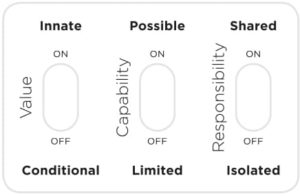
The Tri That Binds: A Meta-Model For Reconciling Process and Content
Share viaThis post is for my blog subscribers who are fans of process models, frameworks that focus on the how of communication. Process is not always easy to explain or teach, and the great minds in our field have contributed tremendously to this. Thanks to the contributions of Dr. Paul Ware, Stephen Karpman, and Taibi Kahler, we have some incredible models to describe and teach process to others. I’d like to suggest a next-generation framework that integrates these models into a unified Tri That Binds – please excuse the play on words.
Ware’s Three Doorways
Dr. Paul Ware, Chief of Psychiatry at LSU Medical Center, identified three “doorways,” three ways of connecting with a person focused on process. By targeting either thoughts, feelings, or behaviors, Dr. Ware could identify a patient’s preferred doorway and quickly establish a connection. This proved to be invaluable not only for building rapport but also for regaining lucid communication, even with patients who were psychotic.
Great process tools help us adapt our communication for better connection.
Karpman’s Drama and Compassion Triangle
Karpman’s Drama and Compassion triangles were a game-changer for understanding the dysfunctional roles people play in drama and the dynamics between these roles. Karpman clarified that drama roles are behavioral positions, so we can distinguish the OK person from the not OK behavior. By suggesting the complimentary Compassion triangle, Kaprman also showed that there are positive behaviors on the flip side of each negative drama role.
Great process tools help us distinguish the person from the behavior.
Kahler’s Miniscript and The Existential Position
Dr. Taibi Kahler’s groundbreaking discovery of the Miniscript identified and made visible for the first time, the second-by-second behaviors that indicated a person was leaving the Existential Position (“I’m OK, You’re OK), and entering a behavioral life position where somebody is only OK under certain conditions, or not OK at all. These behavioral life positions are fueled by the Four Myths, another one of Dr. Kahler’s amazing discoveries.
Dr. Kahler has clarified that there is only one Existential Position, the belief that I am worthwhile and you are worthwhile. Anything else is a behavioral position, again distinguishing the person from the behavior. Where a person is coming from can be identified via behavioral cues of words, tones, gestures, postures, and facial expressions.
Great process tools provide reliable ways to interpret behavioral cues.
The Limitation of Process Tools
Process tools embrace the reality that how you say something is often more important than what you say. Furthermore, they assume that good process helps people show their best selves and reduces miscommunication, which in turn helps reduce negative behavior.
But content still matters. What you say and what you do have real consequences in relationships. Process tools are one type of intervention to reduce negative behaviors, but they don’t directly address behavior. That’s not an indictment of the tool, simply an acknowledgment that process tools aren’t designed to deal directly with content or confront behavior.
Looking For A Meta-Model
Starting in 2010 at Next Element, we began searching for meta-models, frameworks that address process and content. This search was spurred by the frequent requests from our clients for ways to have difficult conversations. Whether the conversation revolved around behavior, charged emotions, or a change initiative, the dilemma was the same, “How do I deal with tough stuff while simultaneously addressing process and content?” This was the impetus for our research and discoveries resulting in our Leading Out of Drama® model and the concept of Compassionate Accountability® which is the process of building connection (process) while getting results (content). Here’s a video outlining the evolution of our LOD and how it departs from Karpman’s model.
Addressing daily challenges with Compassionate Accountability requires an expanded understanding of the existential position; one that guides direct conversations around content while still treating people as OK-OK. After much research, we found a clue in the work of Albert Bandura and the theory of self-efficacy. Self-efficacy is a person’s belief in their ability to organize and execute the behaviors necessary to meet what life throws at them. When it comes to predicting success in life, self-efficacy has a broader and deeper research base than any other model of interpersonal wellness and communication, even Emotional Intelligence. There are three components of Self-efficacy; affective, cognitive, and behavioral. All are critical and all must be addressed to support thriving. As a side note, we created and validated the first context-sensitive self-efficacy outcomes measurement tool, called NEOS, that we use to measure the impact of all our training programs.
The Tri That Binds: Compassionate Accountability And The Three Kinds of OK-OK
To make a long research and testing story shorter, when we settled on our working definition of Compassion, the pieces began to come together.
Compassion is the practice of demonstrating that people are valuable, capable, and responsible in every interaction.
This definition brings together the best of what social and behavioral science has discovered.
- It recognizes that compassion is at the core of healthy, thriving human relationships and cultures.
- Compassion is more than just empathy or kindness. It is an active and dynamic relationship between people.
- Compassion can be learned and takes practice.
- Compassion must be shown in every interaction, so it’s about process as much as content.
- Being OK-OK, the existential position, is more than just being worthwhile. Humans are also capable and responsible. This matters at work, at home, on the court, in the classroom, and in every human relationship.
Because we are valuable, we matter as humans. Everyone deserves to be safe, affirmed, and seen for who they are as a person, with no strings attached.
Because we are capable, what we contribute matters. Everyone deserves the opportunity and invitation to contribute, learn, and grow.
Because we are responsible, our behavior matters. Everyone is 100% responsible for their feelings, thoughts, and behaviors. No more, no less.

We’ve created this visual to represent our meta-model for human behavior and communication. It’s called the Three Switches of The Compassion Mindset™. Each switch is necessary, but not sufficient alone, for optimum communication and thriving. This framework can provide a lens for improving how we look at things, and also a guide for choosing a better course of action.
The whole framework, including how to implement it in your culture, is described in our new book, Compassionate Accountability: How Leaders Build Connection And Get Results.
Our training program, The Compassion Mindset, teaches how to engage in any interaction, conversation, change initiative, or conflict negotiation while keeping your switches on.
Copyright Next Element Consulting, LLC 2023
Get Certified To Teach Compassionate Accountability
Book Your Next Keynote Speaker

Author and Co-founder of Next Element, Dr. Nate Regier is available to speak at your upcoming event.
Submit a Speaker RequestListen to Nate on The Compassionate Accountability Podcast
 Listen to the Podcast
Listen to the Podcast

0 Comments
Add comment